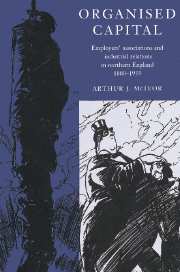Book contents
- Frontmatter
- Contents
- List of maps and tables
- Acknowledgements
- List of abbreviations
- Introduction
- Part 1 Setting the scene
- Part 2 Forging employers' organisations, 1880–1920
- 3 Organisation, membership and solidarity
- 4 Strikebreaking
- 5 Collective bargaining and procedural control
- 6 The impact of the First World War
- Part 3 Reacting to the economic slump, 1920–39
- Conclusion
- Bibliography
- Index
5 - Collective bargaining and procedural control
Published online by Cambridge University Press: 14 October 2009
- Frontmatter
- Contents
- List of maps and tables
- Acknowledgements
- List of abbreviations
- Introduction
- Part 1 Setting the scene
- Part 2 Forging employers' organisations, 1880–1920
- 3 Organisation, membership and solidarity
- 4 Strikebreaking
- 5 Collective bargaining and procedural control
- 6 The impact of the First World War
- Part 3 Reacting to the economic slump, 1920–39
- Conclusion
- Bibliography
- Index
Summary
The conjuncture of rising worker organisation and militancy – an ability and will to sustain resistance – with intensifying competition and more hostile product markets encouraged many employers to seek alternative, less costly and provocative strategies to maintain labour discipline and stabilise industrial relations. Employers' associations played a key role in this process of formalising industrial relations, as this chapter will demonstrate. Not that this was a tidy, symmetrical or neat evolutionary process. Rather, union recognition and collective bargaining mechanisms spread slowly, sporadically and experimentally, in different shapes and forms, at different times and with differing consequences between and within British industries. Nevertheless, an increasing number of employers' organisations– indeed, probably the majority by 1914 – reorientated their labour relations policies towards acceptance of trade unions and towards prevention rather than the forcible breaking of strikes. Increasingly, the local, regional and national employer organisations were stressing the common interests and bonds between master and man, and seeking ways to reconstitute a stronger degree of consent towards capitalism, reversing the process of evaporating loyalty and indiscipline as strikes grew and became more bitter, as companies responded to growing competitive pressures by intensifying workloads and as traditional paternalist relationships fractured as firms grew larger. The secretary of the Oldham Master Builders' Association, Sam Smethurst, articulated a sense of this changing attitude in 1913:
Instead of having a series of struggles all over this vast area it would be better if we could thoroughly understand what is wanted, consider whether it is reasonable and whether we, as the heads of the building trade in this area, could make some recommendations for a settlement that would be friendly instead of antagonistic. […]
- Type
- Chapter
- Information
- Organised CapitalEmployers' Associations and Industrial Relations in Northern England, 1880–1939, pp. 118 - 145Publisher: Cambridge University PressPrint publication year: 1996

